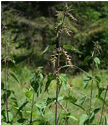 Stinging nettle, known scientifically as urtica dioica, is a herbaceous perennial flowering plant in the family Urticaceae. It is native to Europe, Asia, northern Africa, and North America, and introduced elsewhere. Of its six subspecies, five have many hollow stinging hairs called trichomes on the leaves and stems, which act like hypodermic needles, injecting histamine and other chemicals that produce a stinging sensation upon contact. The plant has a long history of use as a source for traditional medicine, food, tea, and textile raw material.
Stinging nettle, known scientifically as urtica dioica, is a herbaceous perennial flowering plant in the family Urticaceae. It is native to Europe, Asia, northern Africa, and North America, and introduced elsewhere. Of its six subspecies, five have many hollow stinging hairs called trichomes on the leaves and stems, which act like hypodermic needles, injecting histamine and other chemicals that produce a stinging sensation upon contact. The plant has a long history of use as a source for traditional medicine, food, tea, and textile raw material.
A dioecious plant three to seven feet tall in the summer and dying down to the ground in winter, urtica dioica has widely spreading rhizomes and stolons, which are bright yellow, as are the roots. The soft, green leaves are one to six inches long and are borne oppositely on an erect, wiry, green stem. The leaves have a strongly serrated margin, a cordate base, and an acuminate tip with a terminal leaf tooth longer than adjacent laterals. It bears small, greenish or brownish, numerous flowers in dense axillary inflorescences. The leaves and stems are very hairy with non-stinging hairs, and in most subspecies, also bear many stinging hairs (trichomes or spicules), whose tips come off when touched, transforming the hair into a needle that can inject several chemicals causing a painful sting or paresthesia, giving the species its common names: stinging nettle, burn nettle, burn weed, or burn hazel.
It is widely distributed in North America. Nettles are the exclusive larval food plant for several species of butterflies, such as the peacock butterfly, comma (Polygonia c-album), and the small tortoiseshell. It is also eaten by the larvae of some moths including angle shades, buff ermine, dot moth, the flame, the gothic, grey chi, grey pug, lesser broad-bordered yellow underwing, mouse moth, setaceous Hebrew character, and small angle shades. The roots are sometimes eaten by the larva of the ghost moth Hepialus humuli.
Stinging nettle is particularly found as an understory plant in wetter environments, but it is also found in meadows. Although nutritious, it is not widely eaten by either wildlife or livestock, presumably because of the sting. It spreads by abundant seeds and also by rhizomes, and is often able to survive and re-establish quickly after fire.
Urtica dioica produces its inflammatory effect on skin, a stinging, burning sensation often called “contact urticaria,” both by impaling the skin via spicules – causing mechanical irritation – and by biochemical irritants, such as histamine, serotonin, and choline, among other chemicals.
The young leaves are edible and can be used as a leaf vegetable, with a flavor similar to spinach. It is rich in vitamins A and C, iron, potassium, manganese, and calcium. Young plants were harvested by Native Americans and used as a cooked plant in spring when other food plants were scarce. Soaking stinging nettles in water or cooking removes the stinging chemicals from the plant, which allows them to be handled and eaten without injury. After the stinging nettle enters its flowering and seed-setting stages, the leaves develop gritty particles called cystoliths, which can irritate the urinary tract. In its peak season, nettle contains up to 25% protein, dry weight, which is high for a leafy green vegetable. The leaves are also dried and may then be used to make a herbal tea, as can also be done with the nettle’s flowers.
The herb has been used in traditional Austrian medicine internally (as tea or fresh leaves) to treat disorders of the kidneys and urinary tract, gastrointestinal tract, locomotor system, skin, cardiovascular system, hemorrhage, influenza, rheumatism, and gout.
Urtication, or flogging with nettles, is the process of deliberately applying stinging nettles to the skin in order to provoke inflammation. An agent thus used is known as a rubefacient (something that causes redness). This is done as a folk remedy for treatment of rheumatism. In Ecuador there are indigenous healers that use stinging nettles with the belief that they improve fatigue and circulation, by rubbing raw leaves or flogging the plant directly on the body.
Historically, nettles have been used to make clothing for 2,000 years. Nettle stems contain a bast fiber that has been traditionally used for the same purposes as linen and is produced by a similar retting process. Unlike cotton, nettles grow easily without pesticides. The fibers are coarser than cotton. German Army uniforms were almost all made from nettle during World War I due to a potential shortage of cotton. More recently, companies in Austria, Germany, and Italy have started to produce commercial nettle textiles.
From Wikipedia and https://www.calflora.org
SBCSentinel
News of note from around the largest county in the lower 48 states.
